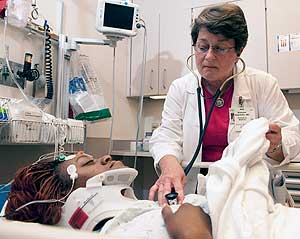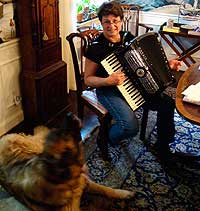As a child, Rosanne S. Naunheim, M.D., had her nose broken three times. Her father, a retired Marine and third-generation barber who liked to box, often hosted matches in the ring tucked in the back of his barbershop. Boxing, he decided, also was the best way for his five children to settle their differences.

Her mother, an executive secretary who strongly believed in education, often rousted her children out of bed as the sun rose for Spanish lessons on a local TV station.
Naunheim also learned to hunt quail and grouse on the family’s farm, perched 500 feet above the Mississippi River Valley in southern Minnesota.
“We were always doing something, and we were big outdoors people,” says Naunheim, now associate professor of emergency medicine.
Naunheim’s parents’ varied influences fueled her natural curiosity. Her colleagues now describe her as unique, prolific and someone who knows a great deal on almost any subject. Her boss also says he’s fairly certain Naunheim is a genius.
“She has an amazing ability to multitask,” says Brent Ruoff, M.D., associate professor and chief of the Division of Emergency Medicine. “She can see multiple patients in the Emergency Department, catch time here and there to read a journal article and still identify patients for her research projects and enroll them. She also picks up disease processes that most of us vaguely remember reading about but apparently miss.”
Timothy Buchman, M.D., Ph.D., founding director of the new Emory Center for Critical Care at Emory University in Atlanta, attended the University of Chicago Pritzker School of Medicine with Naunheim and her husband, Keith Naunheim, M.D., now a professor of surgery at Saint Louis University School of Medicine. Buchman says she is precisely the kind of doctor anyone would want when they’re sick.
“She’s smart, has common sense by the bucketload and gets the job done right the first time, every time,” Buchman says.
After earning a degree in biology in 1970 at Carleton College in Northfield, Minn., Naunheim decided to apply to medical school. A number of her friends were applying, and she had been inspired by the Mayo Clinic physicians who cared for her father, who had leukemia. He died when Naunheim was in high school.
Before her move to attend the University of Chicago, Naunheim had never been in a big city. She enjoyed the ethnic diversity and the many museums and cultural institutions.
She also thrived in medical school.
“It was fantastic,” she says. “The teachers were very excited about what they taught.”
Finding her niche
During medical school, Naunheim decided to specialize in emergency medicine because she liked the variety of cases. She also had the opportunity to work with Peter Rosen, M.D., one of the founding fathers of emergency medicine.

The first patient she took care of as an emergency medicine resident at the University of Chicago Hospitals was a man who, in a drunken stupor, had frozen to death in a block of ice. Her job was to sit with him until he thawed enough so that he could be declared dead.
Naunheim has cared for patients in moments of joy — telling a woman she’s having twins — and for patients who still bring tears to her eyes. She treated a young woman with metastatic breast cancer who wanted to hold the hands of her 2-year-old and 3-year-old as she died.
Working in the Emergency Department (ED), she says, makes one accept that death is a natural part of life, but Naunheim believes that many of her patients’ fates are determined by luck.
“What makes someone become paralyzed in a fall or have a rare genetic disorder?” she says. “Some people simply can’t get a break.”
Research focus
Naunheim was recruited to WUSTL’s emergency medicine division by Lawrence Lewis, M.D., when he became head of the division in 1994. The two had worked together for nine years at Saint Louis University School of Medicine.
Through the years, Naunheim and Lewis became interested in head injuries and how to prevent them. They studied accelerometers in high-school hockey and football players’ helmets to measure the force of blows to the head.
They also researched playground surfaces and concluded that various surfaces have different impact-dampening properties, depending on geographic location and weather conditions. In St. Louis, the safest surface is wood chips, but loose-filled gravel also works well.
Their study, along with political pressure from a number of local groups, prompted the City of St. Louis to change its playground surfaces from asphalt to wood chips or gravel.
|
Rosanne S. Naunheim |
|
Education: B.A. in biology, Carleton College; M.D., University of Chicago Title: Associate professor of emergency medicine Family: Husband, Keith Naunheim, M.D., professor of surgery at Saint Louis University School of Medicine; daughters Kate, senior analyst for an agency that reviews government contracts in Washington, D.C., and Molly, a student at the University of Chicago Pritzker School of Medicine; sons Theo, a student at the University of Missouri School of Law, and Matt, a student at Harvard Medical School Hobbies: Playing accordion, skeet shooting, birding, gardening and traveling. She also enjoys quilting and cooking, which she learned from her grandmother. Fascinated with: Botany. She reads agricultural journals. |
Additionally, Naunheim has studied various types of football fields to determine whether new playing surfaces lower the risk of concussions and other head injuries. She and her colleagues determined that the older, foam-padded surface was just as soft as the newer, shredded rubber-based surface. They also found that the parts of the shredded rubber surface that got the most traffic tended to get compacted and harder.
Recently, she has investigated neurocognitive testing in the ED to determine if patients with head injuries have concussions. Only a small percentage of concussions show up on CT scans. “Many of these patients have no short-term memory in addition to other cognitive problems,” Naunheim says. “Identifying these problems is important because they may indicate that a patient should take a break from sports or from school and might need therapy to improve short-term memory.”
Naunheim hopes that coaches can be trained to administer this simple test on the sidelines to determine if players can return to a game or if they need treatment.
Lewis says Naunheim is tireless, has the most prodigious curiosity of anyone he knows and is not deterred by even the largest of obstacles.
“She also is a great cook, raised four children who have all become very successful in their own right and always brings a unique gift to commemorate any occasion,” he says. “She is an amazing person.”
Naunheim’s daughter Kate works for an agency that reviews government contracts in Washington, D.C.; her son Theo attends law school at the University of Missouri-Columbia; her other son, Matt, is enrolled in Harvard Medical School; and her daughter Molly started at the University of Chicago Pritzker School of Medicine this fall.
A rewarding field
Since she started practicing emergency medicine, Naunheim says the field has changed dramatically. In the late 1970s, emergency medicine physicians followed patients into the Intensive Care Unit (ICU) and continued to care for them. Today, physicians transfer the care of their emergency room patients to an ICU team. Also, doctors formerly relied more on physical exams for diagnoses because they didn’t have ultrasound machines, electrocardiograpy or CT scans.
“But patients have always been grateful for whatever you do,” she says. “It’s a very rewarding field.”
Naunheim says she can’t believe she gets paid to do something she enjoys so much. Her colleagues also are quick to point out how much she likes her job and the resulting benefits to her patients.
“You should see Rosanne Naunheim, M.D., on Friday evenings in the trauma/critical care area,” Buchman says. “She’s conducting an orchestra of caregivers, making sure that some very sick St. Louisans get to see the next sunrise.”